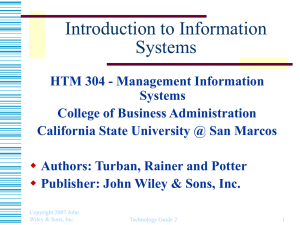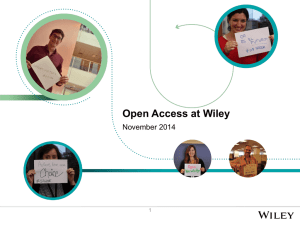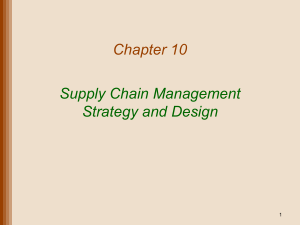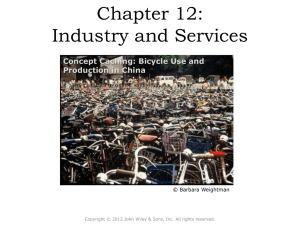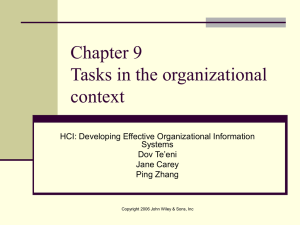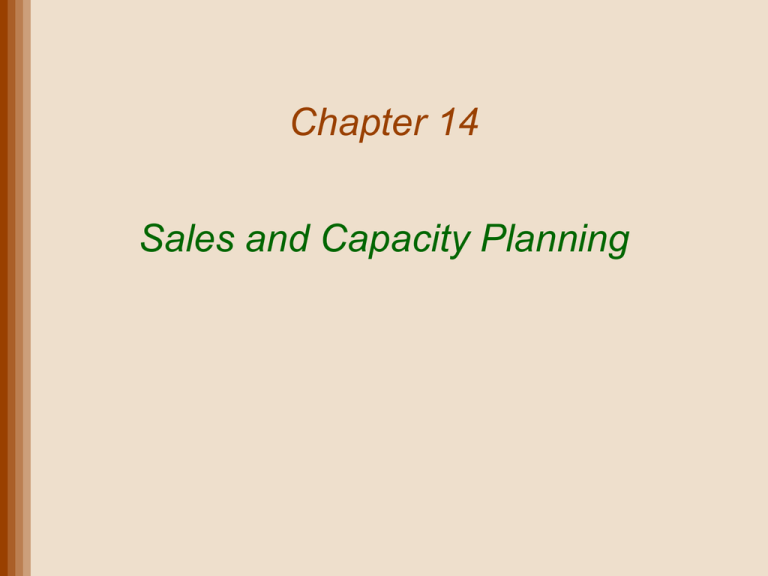
Chapter 14
Sales and Capacity Planning
Lecture Outline
•
•
•
•
•
•
The Sales and Operations Planning Process
Strategies for Adjusting Capacity
Strategies for Managing Demand
Quantitative Techniques for Aggregate Planning
Hierarchical Nature of Planning
Aggregate Planning for Services
Copyright 2011 John Wiley & Sons, Inc.
14-2
Sales and Operations Planning
• Determines resource capacity to meet demand over
an intermediate time horizon
• Aggregate refers to sales and operations planning for
product lines or families
• Sales and Operations planning (S&OP) matches supply
and demand
• Objectives
• Establish a company wide plan for allocating resources
• Develop an economic strategy for meeting demand
Copyright 2011 John Wiley & Sons, Inc.
14-3
Sales and Operations Planning Process
Copyright 2011 John Wiley & Sons, Inc.
14-4
Monthly S&OP Planning Process
Copyright 2011 John Wiley & Sons, Inc.
14-5
Meeting Demand Strategies
• Adjusting capacity
• Resources to meet demand are acquired and
maintained over the time horizon of the plan
• Minor variations in demand are handled with overtime
or under-time
• Managing demand
• Proactive demand management
Copyright 2011 John Wiley & Sons, Inc.
14-6
Strategies for Adjusting Capacity
• Level production
• Producing at a constant rate and using inventory to
absorb fluctuations in demand
• Chase demand
• Hiring and firing workers to match demand
• Peak demand
• Maintaining resources for high-demand levels
Copyright 2011 John Wiley & Sons, Inc.
14-7
Strategies for Adjusting Capacity
• Overtime and under-time
• Increase or decrease working hours
• Subcontracting
• Let outside companies complete the work
• Part-time workers
• Hire part-time workers to complete the work
• Backordering
• Provide the service or product at a later time period
Copyright 2011 John Wiley & Sons, Inc.
14-8
Level Production
Units
Demand
Production
Time
Copyright 2011 John Wiley & Sons, Inc.
14-9
Chase Demand
Demand
Units
Production
Time
Copyright 2011 John Wiley & Sons, Inc.
14-10
Strategies for Managing Demand
• Shifting demand into other time periods
– Incentives
– Sales promotions
– Advertising campaigns
• Offering products or services with counter-cyclical
demand patterns
• Partnering with suppliers to reduce information
distortion along the supply chain
Copyright 2011 John Wiley & Sons, Inc.
14-11
Quantitative Techniques For AP
•
•
•
•
•
Pure Strategies
Mixed Strategies
Linear Programming
Transportation Method
Other Quantitative Techniques
Copyright 2011 John Wiley & Sons, Inc.
14-12
Pure Strategies
QUARTER
SALES FORECAST (LB)
Spring
Summer
Fall
Winter
Hiring cost
Firing cost
Inventory carrying cost
Regular production cost per pound
Production per employee
Beginning work force
Copyright 2011 John Wiley & Sons, Inc.
80,000
50,000
120,000
150,000
= $100 per worker
= $500 per worker
= $0.50 pound per quarter
= $2.00
= 1,000 pounds per quarter
= 100 workers
14-13
Level Production Strategy
Level production
(50,000 + 120,000 + 150,000 + 80,000)
= 100,000 pounds
4
QUARTER
Spring
Summer
Fall
Winter
SALES
FORECAST
80,000
50,000
120,000
150,000
PRODUCTION
PLAN
INVENTORY
100,000
100,000
100,000
100,000
400,000
20,000
70,000
50,000
0
140,000
Cost of Level Production Strategy
(400,000 X $2.00) + (140,00 X $.50) = $870,000
Copyright 2011 John Wiley & Sons, Inc.
14-14
Chase Demand Strategy
QUARTER
SALES PRODUCTION
FORECAST
PLAN
Spring
Summer
Fall
Winter
80,000
50,000
120,000
150,000
80,000
50,000
120,000
150,000
WORKERS
NEEDED
80
50
120
150
WORKERS WORKERS
HIRED
FIRED
0
0
70
30
20
30
0
0
100
50
Cost of Chase Demand Strategy
(400,000 X $2.00) + (100 x $100) + (50 x $500) = $835,000
Copyright 2011 John Wiley & Sons, Inc.
14-15
Level Production with Excel
Cost of level production
= inventory costs +
production costs
Input by user
=400,000/4
Copyright 2011 John Wiley & Sons, Inc.
Inventory at
end of summer
14-16
Chase Demand with Excel
No. of workers
hired in fall
Workforce requirements
calculated by system
Production input by user;
production =demand
Copyright 2011 John Wiley & Sons, Inc.
Cost of chase
demand = hiring +
firing + production
14-17
Mixed Strategy
• Combination of Level Production and Chase
Demand strategies
• Example policies
• no more than x% of workforce can be laid off in one
quarter
• inventory levels cannot exceed x dollars
• Some industries may shut down manufacturing
during the low demand season and schedule
employee vacations during that time
Copyright 2011 John Wiley & Sons, Inc.
14-18
General Linear Programming
(LP) Model
• LP gives an optimal solution, but demand and
costs must be linear
• Let
•
•
•
•
•
Wt = workforce size for period t
Pt =units produced in period t
It =units in inventory at the end of period t
Ft =number of workers fired for period t
Ht = number of workers hired for period t
Copyright 2011 John Wiley & Sons, Inc.
14-19
LP MODEL
Minimize Z = $100 (H1 + H2 + H3 + H4)
+ $500 (F1 + F2 + F3 + F4)
+ $0.50 (I1 + I2 + I3 + I4)
+ $2 (P1 + P2 + P3 + P4)
Subject to
Demand
constraints
Production
constraints
Work force
constraints
Copyright 2011 John Wiley & Sons, Inc.
P1 - I1
I1 + P2 - I2
I2 + P3 - I3
I3 + P4 - I4
1000 W1
1000 W2
1000 W3
1000 W4
100 + H1 - F1
W1 + H2 - F2
W2 + H3 - F3
W3 + H4 - F4
= 80,000
= 50,000
= 120,000
= 150,000
= P1
= P2
= P3
= P4
= W1
= W2
= W3
= W4
(1)
(2)
(3)
(4)
(5)
(6)
(7)
(8)
(9)
(10)
(11)
(12)
14-20
Setting up the Spreadsheet
Target cell;
cost of solution
goes here
Solver will put the
solution here
When model is complete, Solve
Cells where solution appears
Click here next
Demand Constraint
Production Constraint
Workforce Constraint
Copyright 2011 John Wiley & Sons, Inc.
14-21
Setting up the Spreadsheet
Click these boxes
Copyright 2011 John Wiley & Sons, Inc.
14-22
The LP Solution
Cost of optimal solution
Solution is a mix
of inventory, hiring
and firing
Optimal production plan
Extra report
options
Copyright 2011 John Wiley & Sons, Inc.
14-23
Level Production for Quantum
Cost of level production
Excel
calculates
these
Input by user
Level = 12,000/12 = 1,000
Copyright 2011 John Wiley & Sons, Inc.
14-24
Chase Demand for Quantum
No. workers
hired in Feb.
Cost of chase demand
Excel
calculates
these
Input by user
Copyright 2011 John Wiley & Sons, Inc.
14-25
LP Solution for Quantum
Optimal solution
Constraint
equations
in these
cells
Solver found
this solution
Copyright 2011 John Wiley & Sons, Inc.
14-26
Transportation Method
QUARTER
EXPECTED
DEMAND
REGULAR
CAPACITY
OVERTIME
CAPACITY
SUBCONTRACT
CAPACITY
1
2
3
4
900
1500
1600
3000
1000
1200
1300
1300
100
150
200
200
500
500
500
500
Regular production cost
Overtime production cost
Subcontracting cost
Inventory holding cost
Beginning inventory
Copyright 2011 John Wiley & Sons, Inc.
$20/unit
$25/unit
$28/unit
$3/unit-period
300 units
14-27
Transportation Tableau
Copyright 2011 John Wiley & Sons, Inc.
14-28
Transportation Tableau
Copyright 2011 John Wiley & Sons, Inc.
14-29
Burruss’ Production Plan
REGULAR
SUBENDING
PERIOD DEMAND PRODUCTION OVERTIME CONTRACT INVENTORY
1
2
3
4
Total
900
1500
1600
3000
7000
Copyright 2011 John Wiley & Sons, Inc.
1000
1200
1300
1300
4800
100
150
200
200
650
0
250
500
500
1250
500
600
1000
0
2100
14-30
Excel and Transportation Method
Period 2’s
ending
inventory
Regular production
for period 1
Cost of
solution
Copyright 2011 John Wiley & Sons, Inc.
14-31
Other Quantitative Techniques
• Linear decision rule (LDR)
• Search decision rule (SDR)
• Management coefficients model
Copyright 2011 John Wiley & Sons, Inc.
14-32
Hierarchical Nature of Planning
Production
Planning
Capacity
Planning
Resource
Level
Product lines or
families
Sales and
Operations
Plan
Resource
requirements
plan
Plants
Individual
products
Master
production
schedule
Rough-cut
capacity
plan
Critical
work
centers
Components
Material
requirements
plan
Capacity
requirements
plan
All work
centers
Manufacturing
operations
Shop
floor
schedule
Input/
output
control
Items
Copyright 2011 John Wiley & Sons, Inc.
Individual
machines
14-33
Disaggregation
• Breaking an aggregate plan into more detailed
plans
• Create Master Production Schedule for Material
Requirements Planning
Copyright 2011 John Wiley & Sons, Inc.
14-34
Collaborative Planning
• Sharing information and synchronizing
production across supply chain
• Part of CPFR (collaborative planning,
forecasting, and replenishment)
• involves selecting products to be jointly managed,
creating a single forecast of customer demand, and
synchronizing production across supply chain
Copyright 2011 John Wiley & Sons, Inc.
14-35
Available-to-Promise (ATP)
• Quantity of items that can be promised to customer
• Difference between planned production and customer
orders already received
AT in period 1 = (On-hand quantity + MPS in period 1) –
(CO until the next period of planned production)
ATP in period n = (MPS in period n) –
(CO until the next period of planned production)
• Capable-to-promise
• quantity of items that can be produced and mad available at a
later date
Copyright 2011 John Wiley & Sons, Inc.
14-36
ATP
Copyright 2011 John Wiley & Sons, Inc.
14-37
ATP
Copyright 2011 John Wiley & Sons, Inc.
14-38
ATP
Take excess units from April
ATP in April = (10+100) – 70 = 40
ATP in May = 100 – 110 = -10
ATP in June = 100 – 50 = 50
Copyright 2011 John Wiley & Sons, Inc.
= 30
=0
14-39
Rule Based ATP
Product
Request
Yes
Is the product
available at
this location?
No
Available-topromise
Yes
Is an alternative
product available
at this location?
No
Allocate
inventory
Yes
Is this product
available at a
different
location?
No
Copyright 2011 John Wiley & Sons, Inc.
Is an alternative
product available
at an alternate
location?
Yes
No
Allocate
inventory
Capable-topromise date
Is the customer
willing to wait for the
product?
No
Available-topromise
Yes
Revise master
schedule
Trigger production
Lose sale
14-40
Aggregate Planning for Services
•
•
•
•
Most services cannot be inventoried
Demand for services is difficult to predict
Capacity is also difficult to predict
Service capacity must be provided at the
appropriate place and time
• Labor is usually the most constraining resource
for services
Copyright 2011 John Wiley & Sons, Inc.
14-41
Yield Management
Copyright 2011 John Wiley & Sons, Inc.
14-42
Yield Management
Copyright 2011 John Wiley & Sons, Inc.
14-43
Yield Management
NO-SHOWS
PROBABILITY
P(N < X)
0
1
2
3
.15
.25
.30
.30
.00
.15
.40
.70
.517
Optimal probability of no-shows
Cu
75
P(n < x)
=
= .517
Cu + C o
75 + 70
Hotel should be overbooked by two rooms
Copyright 2011 John Wiley & Sons, Inc.
14-44
Copyright 2011 John Wiley & Sons, Inc.
All rights reserved. Reproduction or translation of this
work beyond that permitted in section 117 of the 1976
United States Copyright Act without express permission
of the copyright owner is unlawful. Request for further
information should be addressed to the Permission
Department, John Wiley & Sons, Inc. The purchaser
may make back-up copies for his/her own use only and
not for distribution or resale. The Publisher assumes no
responsibility for errors, omissions, or damages caused
by the use of these programs or from the use of the
information herein.
Copyright 2011 John Wiley & Sons, Inc.
14-45



